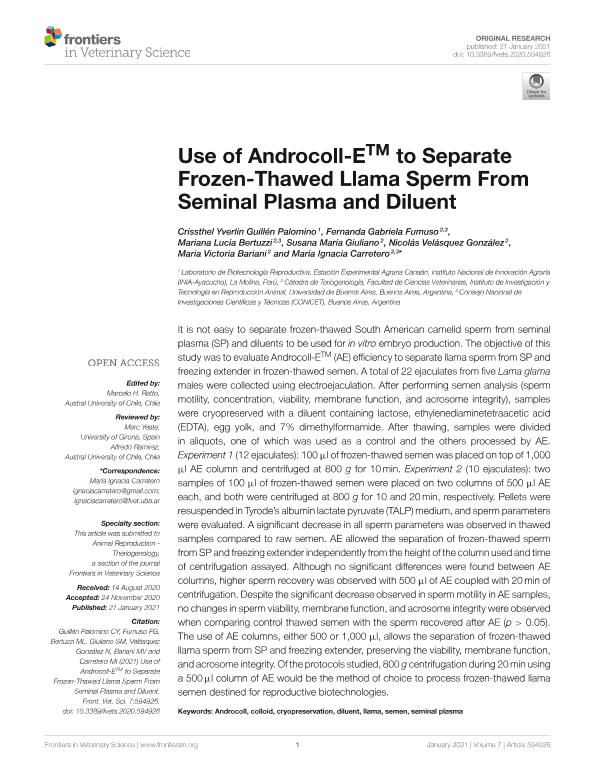Mostrar el registro sencillo del ítem
dc.contributor.author
Guillén Palomino, Crissthel Yverlin
dc.contributor.author
Fumuso, Fernanda Gabriela

dc.contributor.author
Bertuzzi, Mariana Lucía

dc.contributor.author
Giuliano, Susana María

dc.contributor.author
Velásquez González, Nicolás

dc.contributor.author
Bariani, Maria Victoria

dc.contributor.author
Carretero, Maria Ignacia

dc.date.available
2021-12-07T10:29:22Z
dc.date.issued
2021-01
dc.identifier.citation
Guillén Palomino, Crissthel Yverlin; Fumuso, Fernanda Gabriela; Bertuzzi, Mariana Lucía; Giuliano, Susana María; Velásquez González, Nicolás; et al.; Use of Androcoll-ETM to Separate Frozen-Thawed Llama Sperm From Seminal Plasma and Diluent; Frontiers Media; Frontiers in Veterinary Science; 7; 1-2021; 1-7
dc.identifier.issn
2297-1769
dc.identifier.uri
http://hdl.handle.net/11336/148340
dc.description.abstract
It is not easy to separate frozen-thawed South American camelid sperm from seminal plasma (SP) and diluents to be used for in vitro embryo production. The objective of this study was to evaluate Androcoll-E™ (AE) efficiency to separate llama sperm from SP and freezing extender in frozen-thawed semen. A total of 22 ejaculates from five Lama glama males were collected using electroejaculation. After performing semen analysis (sperm motility, concentration, viability, membrane function, and acrosome integrity), samples were cryopreserved with a diluent containing lactose, ethylenediaminetetraacetic acid (EDTA), egg yolk, and 7% dimethylformamide. After thawing, samples were divided in aliquots, one of which was used as a control and the others processed by AE. Experiment 1 (12 ejaculates): 100 μl of frozen-thawed semen was placed on top of 1,000 μl AE column and centrifuged at 800 g for 10 min. Experiment 2 (10 ejaculates): two samples of 100 μl of frozen-thawed semen were placed on two columns of 500 μl AE each, and both were centrifuged at 800 g for 10 and 20 min, respectively. Pellets were resuspended in Tyrode's albumin lactate pyruvate (TALP) medium, and sperm parameters were evaluated. A significant decrease in all sperm parameters was observed in thawed samples compared to raw semen. AE allowed the separation of frozen-thawed sperm from SP and freezing extender independently from the height of the column used and time of centrifugation assayed. Although no significant differences were found between AE columns, higher sperm recovery was observed with 500 μl of AE coupled with 20 min of centrifugation. Despite the significant decrease observed in sperm motility in AE samples, no changes in sperm viability, membrane function, and acrosome integrity were observed when comparing control thawed semen with the sperm recovered after AE (p > 0.05). The use of AE columns, either 500 or 1,000 μl, allows the separation of frozen-thawed llama sperm from SP and freezing extender, preserving the viability, membrane function, and acrosome integrity. Of the protocols studied, 800 g centrifugation during 20 min using a 500 μl column of AE would be the method of choice to process frozen-thawed llama semen destined for reproductive biotechnologies.
dc.format
application/pdf
dc.language.iso
eng
dc.publisher
Frontiers Media

dc.rights
info:eu-repo/semantics/openAccess
dc.rights.uri
https://creativecommons.org/licenses/by/2.5/ar/
dc.subject
ANDROCOLL
dc.subject
COLLOID
dc.subject
CRYOPRESERVATION
dc.subject
DILUENT
dc.subject
LLAMA
dc.subject
SEMEN
dc.subject
SEMINAL PLASMA
dc.subject.classification
Otras Biotecnología Agropecuaria

dc.subject.classification
Biotecnología Agropecuaria

dc.subject.classification
CIENCIAS AGRÍCOLAS

dc.title
Use of Androcoll-ETM to Separate Frozen-Thawed Llama Sperm From Seminal Plasma and Diluent
dc.type
info:eu-repo/semantics/article
dc.type
info:ar-repo/semantics/artículo
dc.type
info:eu-repo/semantics/publishedVersion
dc.date.updated
2021-11-09T18:57:43Z
dc.journal.volume
7
dc.journal.pagination
1-7
dc.journal.pais
Suiza

dc.journal.ciudad
Lausana
dc.description.fil
Fil: Guillén Palomino, Crissthel Yverlin. Instituto Nacional de Innovación Agraria; Perú
dc.description.fil
Fil: Fumuso, Fernanda Gabriela. Consejo Nacional de Investigaciones Científicas y Técnicas; Argentina. Universidad de Buenos Aires. Facultad de Ciencias Veterinarias; Argentina
dc.description.fil
Fil: Bertuzzi, Mariana Lucía. Consejo Nacional de Investigaciones Científicas y Técnicas; Argentina. Universidad de Buenos Aires. Facultad de Ciencias Veterinarias; Argentina
dc.description.fil
Fil: Giuliano, Susana María. Universidad de Buenos Aires. Facultad de Ciencias Veterinarias; Argentina
dc.description.fil
Fil: Velásquez González, Nicolás. Universidad de Buenos Aires. Facultad de Ciencias Veterinarias; Argentina
dc.description.fil
Fil: Bariani, Maria Victoria. Universidad de Buenos Aires. Facultad de Ciencias Veterinarias; Argentina. Consejo Nacional de Investigaciones Científicas y Técnicas; Argentina
dc.description.fil
Fil: Carretero, Maria Ignacia. Universidad de Buenos Aires. Facultad de Ciencias Veterinarias; Argentina. Consejo Nacional de Investigaciones Científicas y Técnicas; Argentina
dc.journal.title
Frontiers in Veterinary Science
dc.relation.alternativeid
info:eu-repo/semantics/altIdentifier/doi/http://dx.doi.org/10.3389/fvets.2020.594926
dc.relation.alternativeid
info:eu-repo/semantics/altIdentifier/url/https://www.frontiersin.org/articles/10.3389/fvets.2020.594926/full
Archivos asociados
